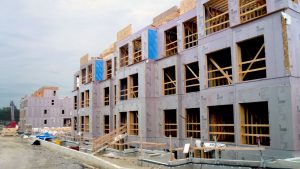Representing the province’s 444 municipalities, the AMO) is calling for a new fiscal relationship with the Ontario government to meet the province’s housing targets and all the other services municipalities are required to provide.
“Municipalities are committed to increasing the supply of housing, especially deeply affordable housing,” says AMO’s policy director Lindsay Jones.
But that commitment is severely hampered by the provincial-municipal fiscal imbalance, she says.
Municipalities are mostly directly involved in providing housing at two critical junctures, the planning and approval process and the delivery of infrastructure services such as water and wastewater services.
To meet the province’s ambitious housing target of 1.5 million new homes by 2031, municipalities intend to spend $250-billion to build new infrastructure services and maintain existing ones.
The $250-billion figure is an “aggregate amount” which AMO determined after analyzing municipal budgets.
And the financial outlook is very unclear under Bill 23 and the province’s announcement that the application of development charges would be restricted, says Jones.
Since that announcement, Paul Calandra, who took over the municipal affairs and housing portfolio after the resignation of Steve Clark last September “has walked that (restriction) back a little.”

Association of Municipalities
of Ontario
The association’s demand for a new fiscal arrangement began last October with a letter to Premier Doug Ford and then that call was “ramped up” in a strongly worded news release which AMO released in January.
AMO president Colin Best pointed out municipal governments across the province want to address affordability, invest in infrastructure and the economy, and tackle social challenges like increasing homelessness.
They actually outspend the provincial government by almost $4 billion each year on provincial responsibilities such as social housing, long-term care, public health and child care, wrote Best.
In tandem with that news release, approximately 100 supporting municipal motions were sent to the province during January and February, says Jones.
Those concerns were not addressed in the recently tabled provincial budget, although the province did allocate an additional $1.6 billion for infrastructure work, she points out.
Noting the province has approved “new deals” for Toronto and Ottawa, AMO will continue to press for a similar deal for the other municipalities. The issue is expected to be a major focus of its upcoming annual conference in Ottawa, says Jones.
The association will also continue to press for implementation on almost 100 housing-related recommendations in the Blueprint for Action report it published in early 2022.
One key recommendation is that affordable housing and homelessness prevention programs are essentially a means for income redistribution. As such, they should not be funded primarily through property tax revenue. It is unsustainable and at odds with basic principles of good public and fiscal policy.
The report also calls for a reversal of the downloading of housing services implemented by the Mike Harris government in the 1990s.
“Ontario is the only Canadian province or territory where municipal governments are responsible for the funding and delivery of community housing. In 2018, property taxpayers contributed over $2 billion towards community housing alone,” the report noted.
Homelessness is growing across the province. There are now nearly 1,400 encampments in municipalities across Ontario. Municipalities are stepping up to address homelessness, but they simply do not have the financial tools needed to solve systemic social problems. In the last five years, property taxpayers have seen a 200 per cent increase in costs to support homelessness services in their communities, the report notes.












Recent Comments
comments for this post are closed